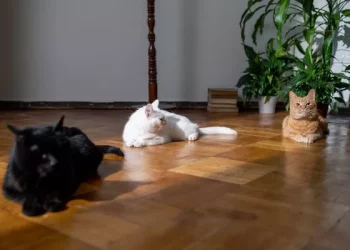Training a Chartreux cat can be a rewarding experience, both for you and your feline companion. Known for their playful nature, intelligence, and affectionate demeanor, Chartreux cats can be trained to follow commands, use the litter box, and even perform tricks. This article will guide you through the essential steps and techniques for effectively training your Chartreux cat.
Understanding the Chartreux Cat
Breed Characteristics
The Chartreux is a unique breed, known for its striking blue-gray coat and copper or gold eyes. These cats are medium to large in size, with a muscular build and a round head. Their short, dense fur is water-resistant, making them excellent hunters. Chartreux cats are not just physically impressive; they also possess a charming personality. They are known to be:
Affectionate: Chartreux cats bond closely with their owners and enjoy being part of the family.
Intelligent: They are quick learners, making them suitable candidates for training.
Playful: Their playful nature means they enjoy engaging in interactive activities.
Quiet: Unlike some breeds, Chartreux cats are generally quiet and tend to communicate through soft chirps and trills.
Living Habits
Chartreux cats are adaptable creatures that thrive in a variety of environments, whether in an apartment or a larger home. They require mental stimulation and physical activity to keep them happy. Here are some key aspects of their living habits:
Social Interaction: They love spending time with their human companions and can become lonely if left alone for long periods.
Playtime: Regular play sessions are crucial. They enjoy toys that mimic prey, like feather wands and laser pointers.
Litter Box Training: Chartreux cats are generally easy to litter train, but it’s essential to maintain a clean litter box to encourage consistent use.
Understanding these characteristics is crucial for effective training. A positive and engaging training environment will help your Chartreux thrive.
Getting Started with Training
Creating a Training Environment
Before you start training your Chartreux cat, it’s important to create a suitable environment. Here are some tips:
Choose a Quiet Space: Find a quiet area in your home with minimal distractions. This will help your cat focus on the training session.
Gather Supplies: Have treats, toys, and a clicker (if you’re using clicker training) ready. Use small, soft treats that your cat loves.
Set a Schedule: Consistency is key. Schedule short training sessions of about 5 to 10 minutes, a few times a day.
Understanding Your Cat’s Motivation
Every cat is different, and understanding what motivates your Chartreux will help you train them effectively. Common motivators include:
Food: Many cats respond well to treats. Use high-value treats that your cat doesn’t get at other times.
Play: Incorporate play into training. Use a favorite toy as a reward for completing a task.
Affection: Some cats respond well to praise and petting. Use a gentle tone and affectionate gestures to reinforce positive behavior.
Basic Commands and Tricks
Training a Chartreux cat can start with simple commands. Here are a few basic commands you can teach:
1. Come When Called
Teaching your cat to come when called is essential for safety and can also be a fun way to engage with your pet.
Steps:
- Choose a command word, such as “come” or “here.”
- Call your cat using the command in a cheerful tone.
- When they approach, reward them with a treat or playtime.
- Repeat this several times, gradually increasing the distance between you and your cat.
2. Sit
The “sit” command is a great starting point for training. It’s a simple action that many cats can learn.
Steps:
- Hold a treat above your cat’s nose, then slowly move it back over their head. This should naturally encourage them to sit as they look up.
- As soon as they sit, say “sit” and give them the treat.
- Practice this regularly until they respond to the command without needing the treat as a lure.
3. High Five
This fun trick can strengthen the bond between you and your cat while also being a crowd-pleaser.
Steps:
- Hold a treat in your hand and let your cat see it.
- Encourage them to paw at your hand to reach the treat. As they do this, say “high five.”
- Reward them with the treat and praise.
- Repeat until your cat understands the trick.
4. Litter Box Training
While most Chartreux cats instinctively know how to use a litter box, you may need to help them adjust to a new environment.
Steps:
- Place the litter box in a quiet, accessible location.
- Keep the box clean and filled with a substrate your cat prefers.
- If your cat has an accident, gently place them in the litter box afterward to help them understand where to go.
Advanced Training Techniques
Once your Chartreux has mastered basic commands, you can move on to more advanced training techniques.
1. Clicker Training
Clicker training can enhance the learning experience for both you and your cat. This technique uses a clicker to mark desired behaviors, followed by a reward.
Steps:
- Start by clicking the clicker and immediately giving your cat a treat. Repeat this several times so they associate the sound with receiving a reward.
- Once they understand the click, use it to mark desired behaviors, such as sitting or coming when called. Click as they perform the action and reward them right away.
2. Agility Training
Chartreux cats are naturally agile and can excel in agility training. Setting up a mini agility course can be a fun way to challenge them.
Steps:
- Create an obstacle course using furniture, tunnels, and jumps.
- Use treats and clicker training to guide them through the course.
- Start with simple tasks, gradually increasing the complexity as they improve.
3. Teaching Your Cat to Walk on a Leash
Walking your cat on a leash can provide exercise and enrichment. It requires patience and practice.
Steps:
- Begin by letting your cat wear a harness indoors for short periods, gradually increasing the duration.
- Once they are comfortable, attach a lightweight leash and allow them to explore your home.
- When they are ready, take them outside in a safe, enclosed area. Keep the sessions short and positive.
Troubleshooting Common Training Issues
Training can come with its challenges. Here are some common issues and solutions:
1. Refusal to Follow Commands
If your cat is not responding to commands, try the following:
Check Motivation: Ensure you’re using high-value treats or toys that motivate your cat.
Reduce Distractions: Make sure your training environment is quiet and free of distractions.
Shorten Sessions: If your cat loses interest, consider shortening the training sessions to keep them engaged.
2. Overstimulation
Sometimes, cats may become overstimulated during play or training sessions. Signs include twitching tails, flattening ears, or sudden bites.
Steps:
- Pay attention to your cat’s body language. If they show signs of overstimulation, take a break.
- Allow them to calm down and resume training when they’re more relaxed.
3. Inconsistent Behavior
If your cat is behaving inconsistently, check for the following:
Consistency: Use the same command for each action and maintain a consistent training schedule.
Reinforcement: Ensure you’re consistently rewarding positive behavior.
Building a Strong Bond Through Training
Training is not just about teaching commands; it’s also about building a strong bond with your Chartreux cat. Here are some ways to enhance your relationship during the training process:
Positive Reinforcement: Always use positive reinforcement techniques. This builds trust and encourages your cat to enjoy training.
Quality Time: Spend time playing and engaging with your cat outside of training sessions. This deepens your bond and makes training more enjoyable.
Patience and Understanding: Remember that every cat learns at their own pace. Be patient and understanding, and celebrate small victories.
Conclusion
Training a Chartreux cat can be a fulfilling journey filled with fun and connection. By understanding their breed characteristics, using positive reinforcement, and employing engaging techniques, you can teach your Chartreux to follow commands, perform tricks, and enhance their quality of life.
Training is an ongoing process, so keep the sessions light, fun, and engaging. With love and patience, your Chartreux will not only learn but also thrive as a cherished member of your family. Enjoy the journey of training and the special bond it creates with your feline friend!
Related Topics:























